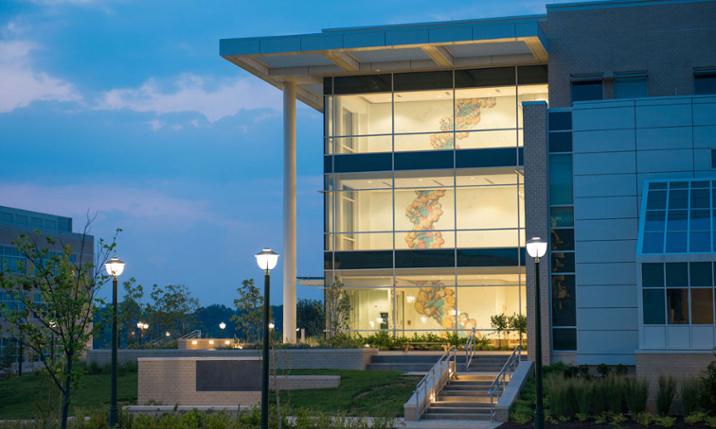Research and Scholarship Q&A with the College of Science and Mathematics
Research
SUMMARY: Continuing our research and scholarship Q&A series, we move to East Campus to learn about research and discovery in the College of Science and Mathematics through an interview with Dean Cynthia Bauerle.
By Benjamin Delp (’05 and ‘08), JMU Research & Scholarship
You began your tenure at JMU in 2016. Since arriving in Harrisonburg, what has impressed you the most with regard to scholarly activities in the College of Science and Mathematics (CSM)?
The past 15 years has seen tremendous growth in research facilities and instrumentation in the CSM, thanks to successful grant efforts and critical university investments. Our research infrastructure enables us not only to support the research activities of current faculty, but also to recruit outstanding new faculty who will drive science and mathematics scholarship in the future. While undergraduate research is well established at most institutions, JMU students have access to really extraordinary opportunities to work side by side with JMU faculty in research labs and field sites. They are the true beneficiaries, as they should be!
CSM houses five departments -- Biology, Chemistry & Biochemistry, Physics & Astronomy, Mathematics & Statistics, and Geology & Environmental Science. What are two or three examples of interdisciplinary research happening among CSM departments? Is there a research focus in the college?
Many of the most exciting areas of discovery today are at the cusps between disciplines, and so it’s no surprise that CSM faculty are engaged in interdisciplinary research. Sometimes interdisciplinarity is borne out of necessity. Biologist Roshna Wunderlich’s research on the evolution of human gait, for instance, has led her to areas of inquiry in which she has collaborated with colleagues in Physics, Kinesiology, and Mathematics. Other times scientists from across disciplines will share a common interest, and that becomes the organizer for collaboration. Faculty from Biology, Chemistry & Biochemistry, Engineering, and Business are interested in product development for industrial hemp in the Commonwealth. In the next 5-10 years, I think we’ll see increased collaboration in data analytics, materials science, genomics/metagenomics, all cutting-edge areas that reflect the increasingly transdisciplinary nature of research in the 21st century.
Thinking about your previous professional experiences at other universities and the Howard Hughes Medical Institute, with regard to research, what is unique or different about scholarship at JMU?
CSM faculty have created a distinctive undergraduate-centered faculty scholarship model that stands out on the landscape of primarily undergraduate institutions. Our faculty is highly research-active, disseminating their work nationally and internationally, and procuring significant extramural funding to support their efforts. They couldn’t do what they do without student involvement. More than just benefiting from opportunities to gain research experience, our undergraduate students are essential partners in our research enterprise.
Our faculty understand the value of research experience and are committed to providing opportunities for every student to participate. This is a tall order given the large number of students we have, so departments like Biology and Geology & Environmental Science are developing “course-based undergraduate research experiences (CUREs)” that enable students to get involved in research from their first day on campus.
The Madison Accelerator Laboratory (MAL), which features a linear accelerator, will be fully operational in the coming months. How will bringing online a lab like MAL create new opportunities for faculty and students?
The Madison Accelerator Laboratory houses our low-energy linear accelerator (LINAC), a powerful instrument in astrophysics research aimed at understanding the nuclear reactions that take place inside stars. It’s another great example of the unique experiences students have access to when they study science at JMU. The lab allows us to pursue national and international research collaborations, and provides our students with opportunities to gain hands-on experience with a technology that is usually reserved for advanced graduate studies. In addition to basic astrophysics research, housing the accelerator on campus expands our ability to pursue applications in many other areas including nuclear medicine, materials science, and forensics.
What sort of changes do you envision for the College of Science and Mathematics over the next five years? What role will research and scholarship play?
We will continue to develop and strengthen our student-centered scholarship model in the CSM in the coming decade. First and foremost, we need to ensure that every student who studies science and mathematics at JMU has access to the best learning opportunities including collaborative research with faculty. This means expanding research opportunities for CSM majors and strengthening curricular options for the students we serve from other programs.
It is critical that we maintain our research capacity including resource development in support of our current facilities as well as strategic growth in emerging areas such as computational modeling, data analytics, and imaging. Our faculty benefit from the strong value our administration places on scholarship, and they will continue to pursue exciting new ways to integrate their research with our teaching mission. We will continue to hire excellent faculty who are committed to participating in our distinctive undergraduate-centered research community.
